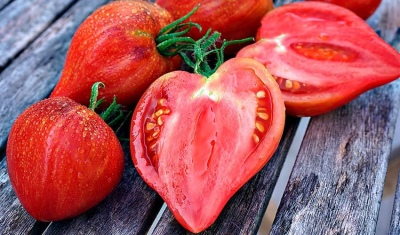
- Authors: Brad Gates, USA
- Name synonyms: Crushed heart, Heart in love, Wounded heart, Broken heart, Crushed heart
- Category: grade
- Growth type: indeterminate
- Appointment: universal
- Ripening period: mid-season
- Ripening time, days: 110-120
- Growing conditions: for greenhouses
- Bush size: tall
- Bush height, cm: 160-180
American selection tomatoes can be a serious help for domestic gardeners. However, each plant actually needs to be studied separately and thoughtfully. This is exactly what you should do with the Crushed Heart tomato.
Breeding history
As already indicated, this is a tomato bred in the USA. The work on its creation was coordinated by the famous Brad Gates. Tomato Crushed Heart is not a hybrid, but the most common variety. The use of the plant in the Russian Federation is not certified. It is not included in the state register.
Description of the variety
It has a number of alternative names:
Broken heart;
Heart in love;
Wounded heart;
Suppressed heart;
Crushed heart.
A broken heart is a decent indeterminant. It is a versatile plant suitable for greenhouse cultivation. The height of the bushes ranges from 1.6 to 1.8 m. Externally, the plant looks graceful. Thin simple foliage is dark green in color.
The main qualities of the fruit
The ripened berries of the Crushed Heart are purple-pink in color. They are necessarily covered with stripes. The presence of purple streaks is also noted. The mass of a single berry ranges from 200 to 400 g. It resembles a heart in shape and has a pointed edge.
1-6 fruits develop on the hand. The number of seeds inside tomatoes is small. Tomatoes will form on simple inflorescences.
Taste characteristics
The sweetness of the pulp is typical of Crushed Heart. Connoisseurs also note its meatiness, which can be considered a serious advantage. And also it is worth emphasizing the juiciness of the berries. The palate will be well balanced.
Ripening and fruiting
The variety belongs to the mid-season group. The ripeness of the berries will be reached 110-120 days after the formation of the earliest green shoots. For this reason, taking into account the characteristics of the climate in a particular area plays an important role.
Yield
Harvesting per 1 m2 can reach 5-6 kg of berries. Therefore, the variety should be considered a completely good solution.
The timing of planting seedlings and planting in the ground
First, you need to decide on the expected time of transplanting into open soil. From this moment, 60-65 days are counted back. By this time, you need to already have prepared soil and well-prepared seeds at the ready. And also it is worth considering the readiness of specific bushes for transplanting into open ground or a greenhouse.

Growing tomato seedlings is an extremely important process, because it largely depends on whether the gardener can harvest at all. All aspects must be taken into account, from seedbed preparation to planting in the ground.
Landing scheme
Do not plant more than 3 Crushed Heart bushes per m2. Higher densities can cause problems. And leaving will be seriously difficult.

Growing and caring
A crushed heart must be pinned. Business is also not complete without the formation of bushes. Formation of 1 or 2 stems is typical. Seeds for seedlings are buried by a maximum of 1 cm.The gap between the holes should be 1.5-2 cm.
It is imperative to sow seeds in moist soil. Open cultivation of seedlings in areas with cold, short summers is not allowed. The height of the bushes makes it imperative to tie them up properly. In addition to additional supports, trellises can also be used. Because of the thermophilicity, it is necessary to carefully protect the planting from pronounced temperature fluctuations.
Even the return of night frosts is critical. That is why it is required to very carefully monitor the microclimate in greenhouses. Open cultivation in any northern regions in the spring without shelter gives little results. Fertilize plantings at least 3-4 times per season. In the fall, they bring in:
rotted compost;
ordinary manure;
poultry manure (or any other organic composition).
Its sensible use is unthinkable without a thorough digging of the site. Mineral complexes are required to be applied directly during planting. Another top dressing is carried out just before the flowers appear on the bushes. Mulching bushes is very important in growing Crushed Heart, especially after watering. If you ignore this point, very unpleasant conditions can ensue.
Additionally, you will need to remove weeds and loosen the ground. Hilling bushes is carried out 10-12 days after planting. The next hilling takes place as needed. Connoisseurs note that greenhouse cultivation of Crushed Heart is much more efficient than cultivation in the open air. In early July, it is recommended to pinch the tops - then the nutrient components will be used for the development of fruits, and not for building up green mass.
Fusarium and late blight are dangerous for the Crushed Heart. Damage is also caused by the defeat of the apical aphid. Dangerous infections are prevented by treating the bushes with a soda solution. An alternative to it is the use of onion infusion aged for two days. Sometimes celandine insists on the same number of days.
In the greenhouse, spider mites can threaten plantings of this variety. It can be prevented by systematic ventilation. It is also important to maintain air humidity between 50 and 60%. If a tick infestation has already occurred, an ash infusion should be used, aged 72 hours. With these rather simple actions, you can achieve a very good effect.




A plant needs different micronutrients at each stage of growth. All fertilizers can be divided into two groups: mineral and organic. Folk remedies are often used: iodine, yeast, bird droppings, eggshells.
It is important to observe the rate and period of feeding. This also applies to folk remedies and organic fertilizers.



























































































